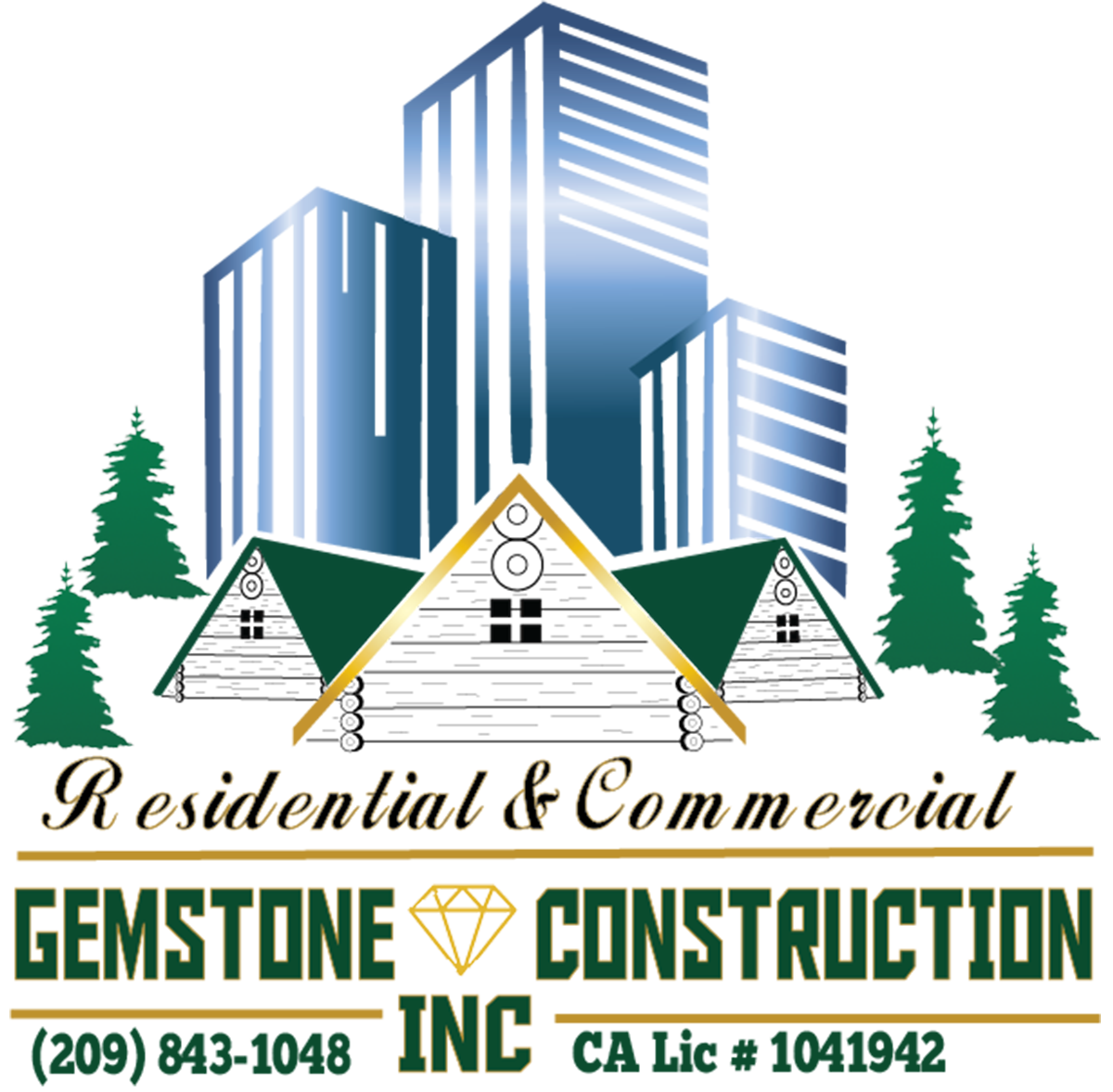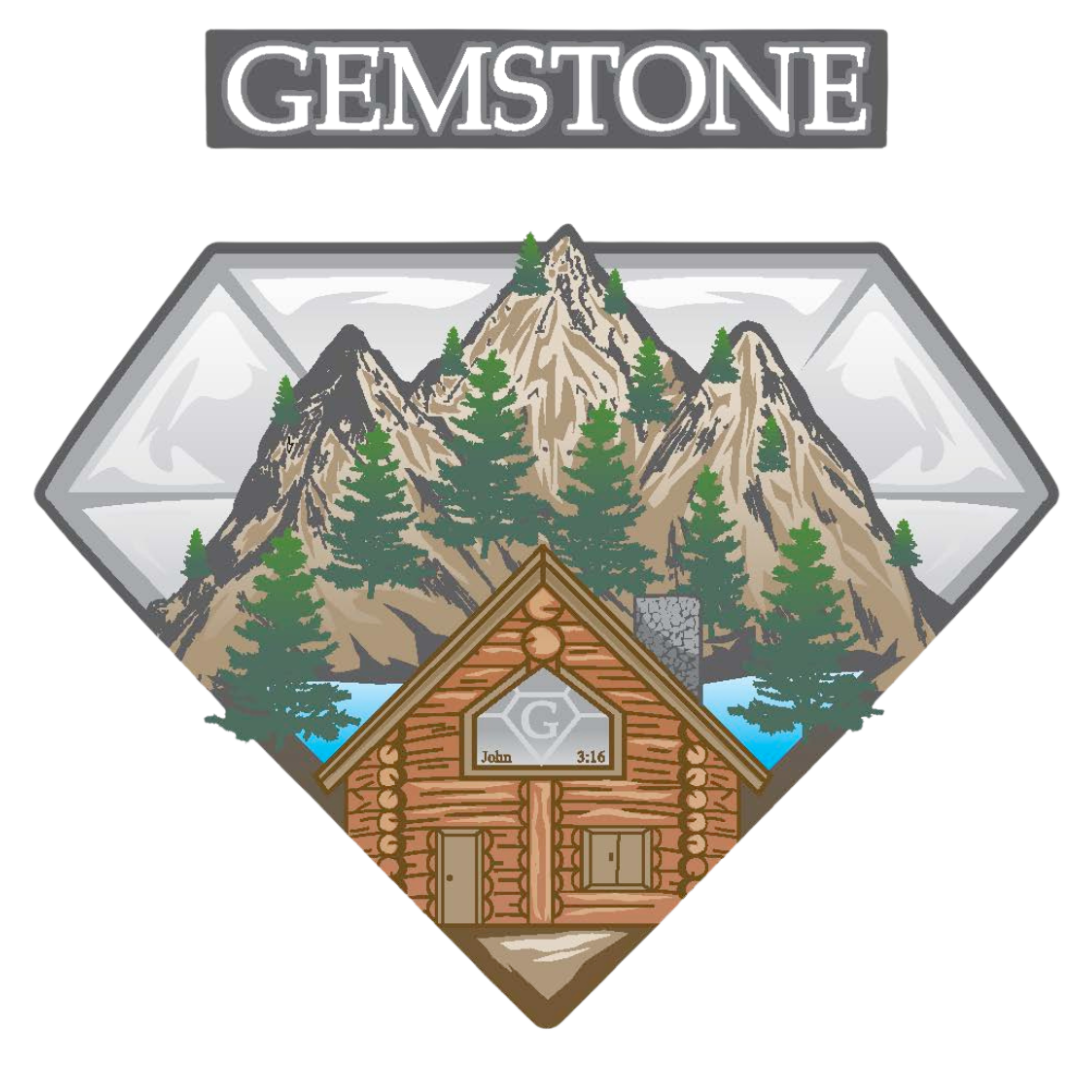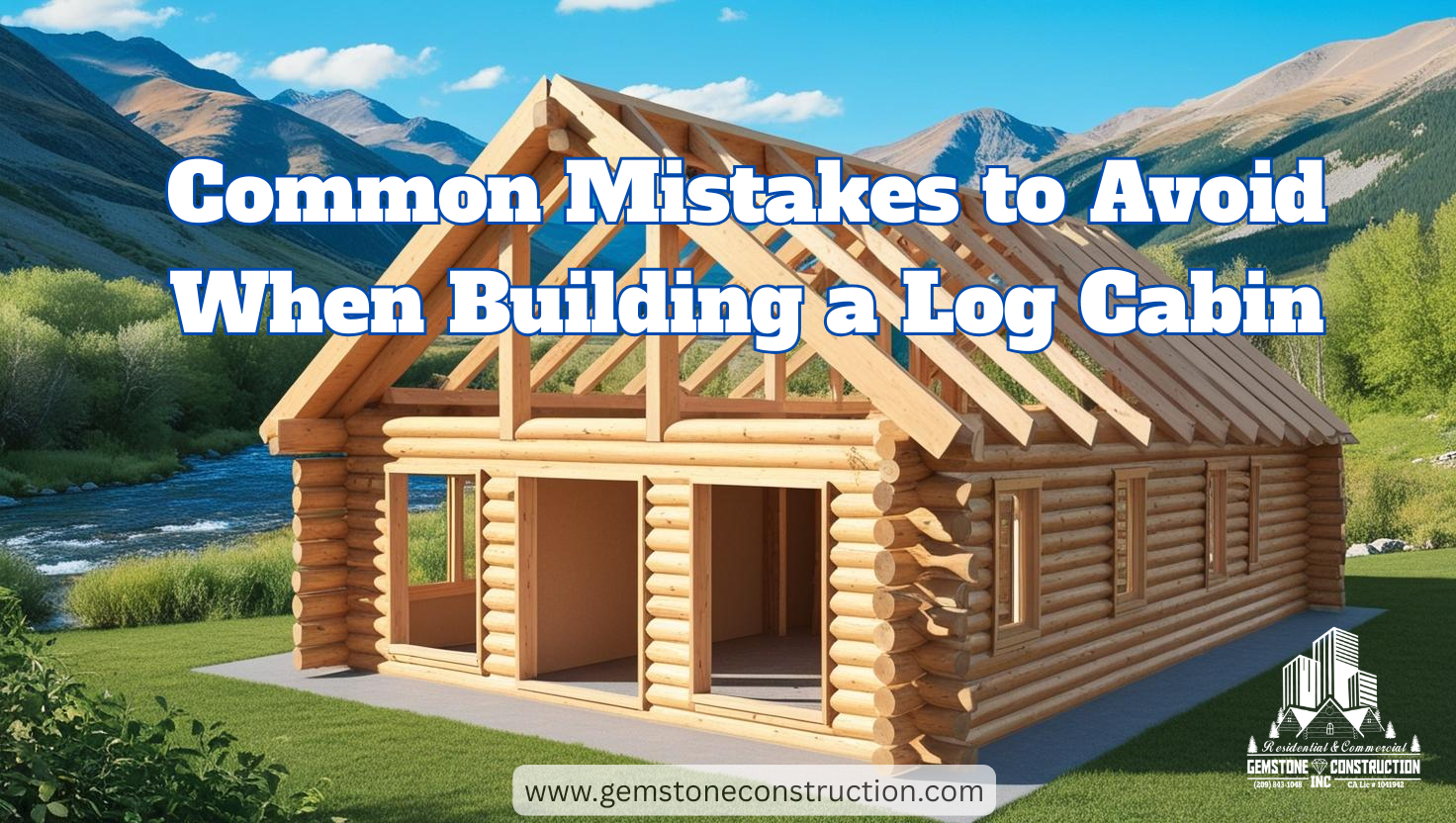GemStone Construction Blog
Common Mistakes to Avoid When Building a Log Cabin
May 9, 2025 | Sacramento, CA USA
Introduction to Building a Log Cabin
Log cabins have always captured the imagination of those seeking a simpler, more connected lifestyle. There’s something timeless about the warmth of natural wood, the crackling of a fire, and the feeling of being surrounded by nature. From the towering redwoods of Northern California to the sunlit valleys of Napa, these rustic homes offer a unique living experience that blends tradition with modern comfort. However, building a log cabin is not a decision to take lightly. It requires careful planning, skilled craftsmanship, and a deep understanding of natural building materials. Without these critical elements, your dream cabin can quickly become a costly headache.
Proper planning and execution are the foundations of a successful log cabin project. Unlike conventional homes, log cabins present unique challenges, including the natural movement of wood, complex moisture management, and the need for precise craftsmanship. These factors make the planning phase especially important. It’s during this stage that you decide on the design, materials, and site location – all of which will have a significant impact on the long-term durability and comfort of your home.
At Gemstone Construction, we understand the passion that drives people to build their dream log cabins. With decades of experience as a log home builder in Northern California, we specialize in helping homeowners bring their visions to life. From the dense forests of the Sierra Nevada to the picturesque vineyards of Napa, our team has the expertise to guide you through every step of the process, ensuring your cabin stands strong for generations. Here are some of the most common mistakes to avoid when building a log cabin.
Choosing the Wrong Location
Choosing the right location for your log cabin is one of the most important decisions you will make. While the idea of a secluded, picturesque site is tempting, it’s essential to consider the practicalities of your chosen location. Site selection mistakes are among the most common issues that can derail a log cabin project. For example, building on unstable soil or in a flood-prone area can lead to foundation problems, water damage, and expensive repairs. The soil type, drainage, and slope of your building site all impact the stability and longevity of your cabin’s foundation.
Terrain and climate also play a significant role in the durability of your log cabin. In Northern California, the weather can vary dramatically from the foggy coastlines to the dry, hot valleys. If your cabin is exposed to high winds, heavy rainfall, or extreme heat, it’s critical to choose logs that can withstand these conditions. For instance, logs that are naturally resistant to rot and insect damage, like cedar, are better suited for humid or wet climates, while denser woods like Douglas fir are more appropriate for dry, high-altitude locations.
Access to utilities and emergency services is another crucial consideration. While a remote, off-grid cabin might seem romantic, the cost of running power lines, drilling a well, or installing a septic system can quickly add up. Additionally, emergency access for fire crews or medical responders can be limited in remote areas, which is particularly concerning in wildfire-prone regions like California. Working with experienced builders like Gemstone Construction can help you assess the suitability of your chosen site, ensuring it meets all the practical requirements for a successful build.
Skimping on Design and Planning
Rushing through the design and planning phase is a mistake that can lead to countless headaches during construction and long after your cabin is built. The dangers of poor planning include everything from inefficient floor plans to structural weaknesses and energy inefficiency. Without a detailed design, you may find yourself making costly changes halfway through construction or, worse, dealing with structural issues that compromise the safety and longevity of your cabin.
A well-designed log cabin should consider everything from the placement of windows for optimal natural light to the thickness of the logs for proper insulation. It should also include a detailed layout for plumbing, electrical wiring, and HVAC systems, all of which can be more challenging to install in a log structure. Additionally, your design should reflect your lifestyle, incorporating features like outdoor decks, cathedral ceilings, or large, open living spaces that enhance the cabin’s rustic charm while providing modern comfort.
Integrating modern features without losing the rustic appeal of a log cabin can be a delicate balance. While it’s important to include energy-efficient windows, high-quality insulation, and modern kitchen appliances, these elements should complement the natural beauty of the logs rather than detract from it. Gemstone Construction specializes in custom log cabin designs that blend the best of both worlds, creating homes that are as functional as they are beautiful.
Ignoring Proper Log Selection
Choosing the right logs is one of the most critical decisions you will make when building a log cabin. Not all logs are created equal, and selecting the wrong type can lead to significant problems down the road. For example, cedar is naturally resistant to rot and insects, making it a popular choice for humid climates, while pine is more affordable but requires more maintenance. The density, moisture content, and grain structure of the logs you choose will directly impact the longevity, energy efficiency, and maintenance requirements of your cabin.
Logs that are not properly dried can shrink, crack, and warp over time, compromising the structural integrity of your cabin. This is especially true in regions with extreme temperature fluctuations, like the mountains of Northern California. Logs should be air-dried or kiln-dried to reduce moisture content before construction begins. Gemstone Construction sources only the highest quality logs, ensuring your cabin is built to last.
Balancing aesthetics, function, and budget is crucial for a successful log cabin project. While it might be tempting to choose logs based solely on their appearance, it’s important to consider how the wood will perform over time. Logs with tight grain patterns and high resin content tend to be more durable and resistant to decay, while lighter, less dense woods may require more frequent maintenance. Working with a knowledgeable log cabin builder can help you strike the right balance between cost, aesthetics, and long-term durability.
Overlooking Moisture Management
Moisture is one of the greatest threats to the long-term durability of a log cabin. Without proper moisture management, logs can absorb water, swell, crack, and eventually decay. This can lead to rot, mold, and even structural failure if not addressed early in the design and construction phases. Moisture-related problems are particularly common in Northern California, where rainy seasons can be intense and persistent. Ignoring this critical aspect of log cabin construction can result in expensive repairs and a significantly reduced lifespan for your home.
Proper site preparation is the first line of defense against moisture damage. Your cabin’s foundation should be elevated, and the surrounding ground should be graded to direct water away from the structure. This prevents water from pooling around the base of the cabin, where it can seep into the logs and cause decay. Proper drainage systems, such as French drains, are essential for keeping the foundation dry and stable. In addition, wide roof overhangs, gutters, and downspouts are critical for directing rainwater away from the logs, preventing long-term damage.
Sealing the logs themselves is another critical step in moisture management. Logs naturally absorb moisture, and without a high-quality sealant, they can swell, crack, and deteriorate over time. Regular staining and sealing help prevent water infiltration and protect against UV damage, which can dry out the logs and cause them to split. For more tips on maintaining your log cabin’s integrity, check out our article on Log Home Maintenance: Protect Your Rustic Retreat for Generations. Long-term maintenance, including periodic inspections and repairs, is essential for keeping your log cabin in peak condition.
Neglecting Energy Efficiency
While log cabins are often praised for their natural insulation, this doesn’t mean you can ignore energy efficiency. Proper insulation is critical for comfort and cost savings, especially in regions with extreme temperature fluctuations. Logs alone provide some insulation, but they also have high thermal mass, meaning they absorb and slowly release heat. This can help stabilize indoor temperatures, but it also means your cabin will be more affected by seasonal changes without proper planning.
Understanding R-values and thermal mass is essential for maintaining a consistent indoor climate. R-value measures a material’s resistance to heat flow, while thermal mass refers to a material’s ability to absorb and store heat. For example, thick, dense logs have a high thermal mass, which can help keep your cabin cool in summer and warm in winter. However, without proper insulation in the roof, floors, and windows, much of this thermal efficiency can be lost.
To improve energy efficiency, consider adding modern insulation materials, high-quality windows, and strategically placed doors. Insulating between the logs, installing energy-efficient windows, and using tight-fitting doors can significantly reduce your heating and cooling costs. Additionally, consider incorporating passive solar design elements, like south-facing windows, to maximize natural heat gain during the winter months. Gemstone Construction can help you integrate these energy-saving features into your log cabin design, ensuring your home is as comfortable as it is beautiful.
Choosing the Wrong Contractor
Not all contractors are created equal, and choosing the wrong one can lead to significant delays, cost overruns, and poor craftsmanship. Unlike conventional home builders, log cabin contractors require specialized skills and experience to properly cut, fit, and seal logs. They must also understand the unique challenges of building with natural materials, including moisture management, settling, and shrinkage. Choosing a contractor who lacks this expertise can result in a structurally unsound cabin that requires constant maintenance.
Key questions to ask before hiring a log cabin contractor include: How long have you been building log homes? Can you provide references from past clients? What is your experience with local building codes and permit requirements? Do you have experience working with the specific type of logs I plan to use? A reputable contractor should be able to provide detailed answers to these questions and offer examples of past projects similar to yours.
The importance of experience in custom log home construction cannot be overstated. Experienced contractors like Gemstone Construction understand the nuances of log building, from selecting the right logs to ensuring proper moisture control and energy efficiency. They can also guide you through the permitting process and help you avoid costly mistakes that can delay your project or compromise the safety of your cabin.
Failing to Budget for Unexpected Costs
Building a log cabin is a significant financial investment, and failing to budget for unexpected costs can quickly derail your project. Hidden costs can include everything from site preparation and excavation to permits, inspections, and utility connections. In addition, log cabins often require specialized tools, materials, and labor, which can add to the overall cost.
Budgeting for site preparation, permits, and utilities is essential for avoiding financial surprises. For example, if your site requires extensive grading or excavation, this can add thousands of dollars to your budget. Similarly, installing a septic system, well, or off-grid power source can be costly if not planned for in advance. These costs can quickly add up, especially in remote locations where access to utilities is limited.
Why a contingency fund is essential cannot be overstated. Even the best-planned projects can encounter unexpected challenges, from supply chain delays to weather-related setbacks. A contingency fund of 10-20% of your total budget can provide a financial cushion, allowing you to handle unexpected expenses without compromising the quality of your build. Gemstone Construction can help you create a realistic budget that accounts for these potential costs, ensuring your project stays on track.
Ignoring the Permitting Process
The risks of building without proper permits can be severe, including fines, forced demolition, and legal battles. Many first-time builders underestimate the importance of permits, assuming that a remote cabin in the woods is exempt from local building codes. However, this is rarely the case. Most counties in California have strict regulations regarding fire safety, septic systems, electrical work, and structural integrity. Failing to obtain the proper permits can lead to significant delays and unexpected costs.
Building codes impact log cabin construction in several critical ways. For example, in wildfire-prone areas, you may be required to use fire-resistant materials or create defensible space around your cabin. You may also need to meet specific energy efficiency standards or install a certain type of foundation to account for soil stability and seismic activity. These requirements can vary widely depending on your location, making it essential to work with a contractor who understands local regulations.
Working with experienced builders like Gemstone Construction can help you navigate the permitting process, ensuring your cabin is built to code and free from legal complications. They can also advise you on the best practices for meeting local regulations, from selecting fire-resistant logs to designing energy-efficient floor plans. This not only reduces the risk of costly fines but also ensures your cabin is safe, durable, and built to last.
Conclusion
Building a log cabin is a rewarding but challenging endeavor. Avoiding these common mistakes can save you time, money, and frustration, ensuring your cabin stands strong for generations. If you’re ready to build your dream log home in Northern California, from the rolling hills of Napa to the lush forests of the Sacramento Valley, contact Gemstone Construction today. Building your dreams isn’t just a motto – it’s what we do.
About Gemstone Construction
Gemstone Construction is a premier custom home and commercial building contractor serving Northern California, including the Sacramento area. Specializing in
custom log homes,
luxury home builds,
residential metal building construction, commercial construction and
commercial metal building construction. We bring craftsmanship, attention to detail, and personalized service to every project. From designing dream homes to building cutting-edge commercial spaces, our dedicated team ensures that each build reflects our clients' unique vision and exceeds expectations. Trust Gemstone Construction to transform your ideas into reality with integrity and excellence.
Learn more about Gemstone Construction

Contact Information



